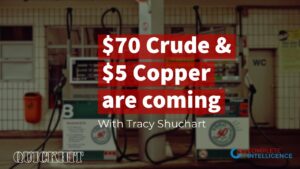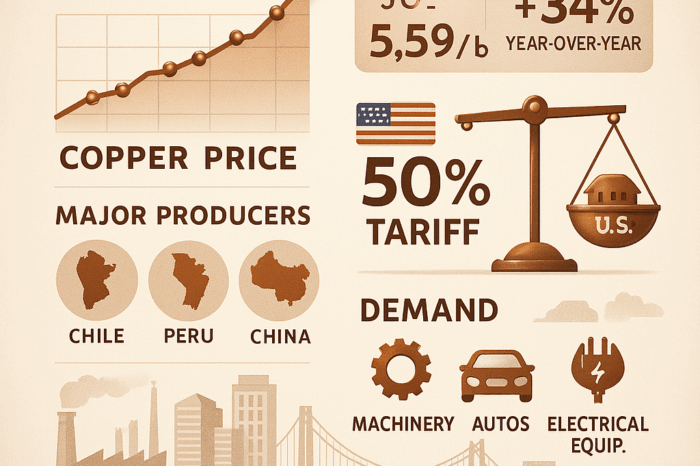$5 Copper. Coming or Averted?

It looks like the market has averted the threat of $5 copper, however, this appears to be more through financial dynamics than through market forces.
Prior to last week’s Federal Reserve statement confirming a strong market, rising inflation and that interest rates will be rising sooner than some expected, commodity prices, inclusive of copper, had been in the high $4 range.
The Fed’s message, coupled with media reports that the Chinese government was going to release government inventories some commodities, inclusive of copper, has driven the price down.
According to an article in the Wall Street Journal mentioned in the June 17th edition of InvestorPlace Digest, “China said it would begin to sell major industrial metals from state stockpiles, an effort to squelch factory-gate price increases that have hit a 13-year high and are stoking fears of global inflation.
As the world’s biggest buyer of a range of industrial commodities, China is using its market heft to try to quell the sharp rise in global metal prices over the past 12 months, including a 67% surge in copper, a bellwether for macroeconomic health.”
So, two government-driven dynamics that artificially affected the price of copper. And the Chinese action could also be inferred as a vehicle to “manipulate” the market. Could they have released / used their stored inventory sooner? Will they begin to restock their warehouse and keep it from the market if they want the price of copper to rise?
But, $5 copper is a prospective reality given traditional supply and demand dynamics. Consider:
Copper is a diminishing commodity. The Earth only has so much of it and only some of it is commercially viable to extract and process. So, there is a supply constraint.
Demand exceeds / will exceed supply. Supply historically grows at 2% but it is currently growing faster. Why?
- Economic recovery. The US GDP is currently projected to grow 7% in 2021. The residential market is strong and, with the recovery, commercial construction (new and renovation), is rebounding. Couple this with growth in the industrial sector (product production and efforts to reshore / expand domestically), the US market is poised for continued growth (even if longer-term growth rates decline, it is still growth.)
- A COVID induced recovery will also come to other countries as more vaccinations are given.
- The Chinese economy has rebounded from COVID.
- The push to “green” involves more copper usage. Electric vehicles use more copper than combustion engine driven vehicles. While EVs are a small percentage of the market, they are expected to grow significantly in the coming years.
- Washington talks about an infrastructure program. Regardless of which program “wins”, it is inevitable that there will be some type of infrastructure program. The result will be more copper demand for infrastructure program financed programs – from core infrastructure projects to building renovations and more (especially if an EV infrastructure program is included.)
- As the government seeks to stimulate growth in new industries – semi-conductors, other technologies, processing of rare-earth minerals, etc – all of these will inevitably drive construction needs … and copper utilization.
And in some parts of the world, COVID is still impacting labor at copper mines.
Randy Pinkofsky, president of The Yanow Companies, a New England electrical manufacturer rep, closely follows the copper market as he represents a number of copper-influenced lines. He has shared some articles from Kitco Metals and other sources on the copper market. Some excerpts from recent articles include:
The main factors driving prices higher are increased Chinese orders amid a strong manufacturing sector; expectations of a return to growth following a disastrous 2020; trillions in promised green and blacktop infrastructure spending particularly in the US, Europe, and China; and supply disruptions resulting from virus-related mine closures.
The climate imperative
Cleaning up the planet will not be possible without major reductions in carbon emissions, and no metal is more important than copper in powering energy systems and green technologies.
According to the Copper Alliance, renewable energy uses up to 12 times more copper than conventional power systems, and improves energy efficiency. The organization predicts copper consumption will increase more than 40% by 2035, driven partly by solar and wind power, and electric vehicles.
Consider the following quotes regarding copper and the climate imperative, pulled from the headlines in recent days:
- Alternative energy systems have a high—and often, unappreciated—materials intensity, of which copper is a major constituent. To quantify the relationship, 30,000 BEVs can consume as much copper as a skyscraper, like the 600,000 square meter Yi Fang Center in Shenzhen (Chinese buildings are close to 50% of global building stock). To turn over just 1/3 of the global passenger vehicle fleet (China currently comprises about 1/3 of passenger vehicles in operation) would require placing into service more than 300 million BEVs. These could collectively contain 20 million tons of copper, almost equal to current annual total world consumption. (Forbes)
- The U.S. recovery is accelerating and President Joe Biden’s $2.25 trillion infrastructure plan will highlight sectors like electric cars, driving further gains in commodities critical to the green-energy transition. That’s coming alongside a continued economic boom in China, where a push to reduce emissions is filtering through to supply cuts for some metals just as demand is picking up. (Bloomberg)
- Traditionally, roughly half of all copper demand has come from new building construction and infrastructure… and China has been the single biggest market by far. With many global economies in or entering recovery phases, cyclical demand is on the upswing. Green initiatives around the world offer a secular tailwind as well. The European Green Deal, President-elect Joe Biden’s ambitious climate plan, and China’s target of carbon neutral by 2060 all point to increasing incremental demand for copper. (Barron’s)
- “Copper is going to be a key metal required to build out the infrastructure that will deliver renewable, lower-carbon energy to end users,” said Daniel Greenspan, senior analyst and resource team director with CIBC Asset Management. “We believe significant mine supply response will be required to meet this new area of demand growth and a higher copper price will be needed to incentivize the new production into the market. (Advisor’s Edge)
A Forecast
And if you want to see a forecast that an energy analyst made back in December, check out this video. (Caution, the quality of the video is “poor” with the audio a little garbled.)
Looking forward
Longer-term, expect it to inch higher with periodic spikes due to episodic issues (i.e. mining issues). Diminishing commodity that will experience increased demand from non-construction sources unless alternatives considered. One company investing in alternatives is Rockwell. Yes, it’s unusual to consider Rockwell in a discussion about copper, however, they just invested in Infinitum Electric, which manufacturers a copper-less electric motor. What other applications could be reconceived to use less copper?
So, while the price of copper has declined, be cautious as the dynamics are in place for a rise. If China changes its mind … all bets could be off.
And with copper representing 15-20% of a distributor’s sales, and hence inventory, fluctuations in inventory value as well as gyrations of sales with nominal incremental gross margin, need to be watched carefully … while guiding your customers cautiously. We wrote about some of these challenges earlier in the year and, coincidentally, ten years ago!
What’s your projection?
























